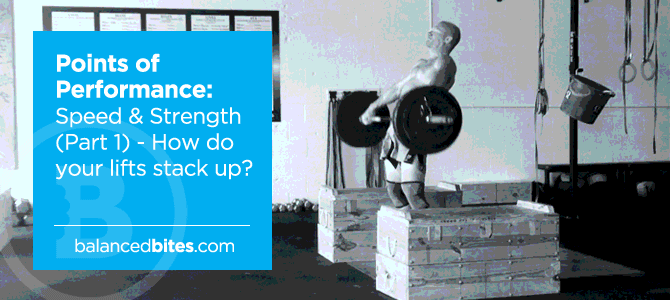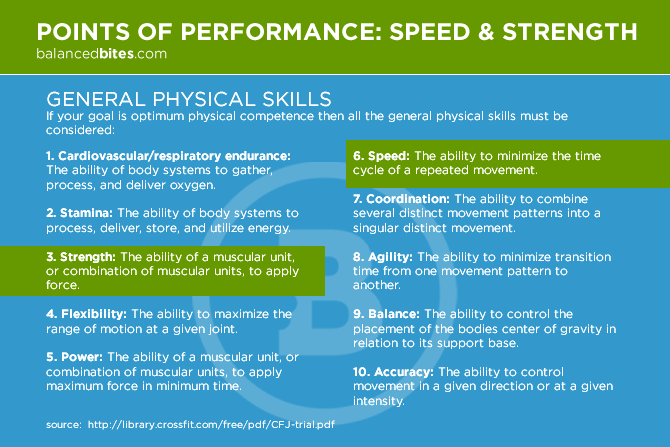In this Points of Performance blog post series, we will look closer at the relationship between strength and speed, help you identify if you have in fact struck a balance between them, and what to do about if you have not.
Step into any CrossFit gym and you’ll likely see the “10 General Physical Skills” stenciled on a wall. You may already familiar with them but, if not, they are: strength, speed, power, stamina, cardio-respiratory endurance, balance, accuracy, agility, flexibility and coordination.
The goal of any well-rounded strength and conditioning program should be create a balance amongst these skills. And one of the basics tenets of CrossFit is that you are only as fit as you are balanced in these skills.
With CrossFit gaining popularity and drawing from a wider audience than ever before, any given class could include former marathoners, stay at home moms, former globo-gym rats and Division 1 athletes in it. Each of these individual athletes come from vastly different training backgrounds, have different work capacities, and likely have imbalances between strength and speed that are keeping them from optimizing their performance in “The Sport of Fitness.”
Let’s first define our two skills:
Strength is the ability of a motor unit or a combination of motor units to apply force.
Speed is the ability to minimize the time cycle of a repeated movement.
Strength and speed both contribute positively to power so it is easy to see that a deficit in either compromises your ability to produce power. We could do an entire series about why these deficits occur so for now we’ll simplify with a few; improper training stimulus, inconsistent training and skill acquisition.
How are strength and speed deficits created?
1. Improper training stimulus.
Spending too many years doing Long Slow Distance efforts or just Powerlifting movements fits well into this category. Both of these training styles have one thing in common; they lack speed.
2. Inconsistent training.
“Cherry Pickers” or those who only show up to do WODs they are good at are inconsistent with their training. In addition, frequently those who write their own programming will unintentionally omit movements they struggle with because of bias.
3. Skill acquisition.
The ability to quickly mobilize the hips and or extremities is a skill that must be learned and requires proper central nervous system activation.
Do you fit into one or more of these categories? If so, you may have an speed/strength imbalance. That is to say, you may be stronger than you are fast or perhaps faster than you are strong. The greater the imbalance, the further you are away from being a truly well rounded athlete.“Ok, so how do I determine if I am balanced or not.”
At my facility, CrossFit Redline, twice per year we test our members on a number of lifts and compare them to each other. The lifts are both strength and speed based, and mixed generously between upper and lower body: pushing, pulling, and squatting.
How is it testing for these points done?
Ask yourself these questions:
1. Is my Dead Lift 125% of my Back Squat?
2. Is my Front Squat 85% of my Back Squat?
3. Is my Power Clean 65% of my Back Squat?
4. Is my Power Snatch 51% of my Back Squat?
5. Is my Close Grip Bench Press equal to my Power Clean?
6. Is my Shoulder Press 65% of my strict weighted Pull Up (bodyweight included)?
If you don’t know the answer to these or aren’t sure: take the time to find out.
If the numbers all jive: you’re in good shape and your programming is working well for
you.
If the numbers don’t line up: which ones are out of place?
Are you stronger than you are fast? Maybe you are faster than you are strong? Have you been consistent with your training? Is your technical skill with the Olympic lifts sound?
Use this chart for assessment purposes – print it, share it, track your information.
In my next post we’ll dive into how to bring these numbers into focus and balance your strength and speed for optimal performance.




Comments 3
This is a great article and gives some good ideas for personal benchmark setting. The only “balance” I demonstrate from the above suggestions is Deadlift to Back Squat @ 130%. Beyond that, from greatest deviation to least, I apparently need to bring up my strict press (-13.1%), front squat (-11.4%), snatch (-7.6%) and then clean (-6.5%).
Haven’t tested my close-grip bench.
I’m DEFINITELY looking forward to the next installment!!!
This is an interesting article but do you have anything geared more towards fuel for endurance training ie cycling, jogging.
Hi. Sorry. I didnt fill my email in correctly.
I wanted to know if you had a plan for endurance fueling. Thanks